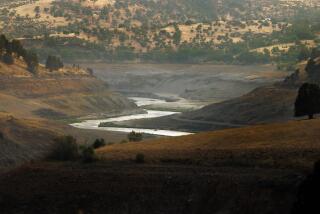Where are the salmon?
- Share via
Though there has been much reporting on the salmon crisis, like The Times’ recent “U.S. halts commercial salmon season” and the New York Times’ ”The trouble with salmon,” no one has yet pointed out that the high numbers in 2002 were actually anomalous or that the increasing variability in salmon, bird and plankton populations all point to climate change as the main driving factor.
The crash of salmon populations in California, Oregon and British Columbia this past fall has a lot of people worried. Just a few years ago, we enjoyed record runs of salmon in the Columbia, Klamath, Fraser and Sacramento river systems. Indeed, these runs were so high that they made us forget that salmon have not been faring well in the Pacific Northwest and northern California for some time.
Back in 2002, upward of 800,000 fall-run chinook salmon graced the Sacramento River and 390,000 spring Chinook traversed the Columbia. In 2003, 610,000 fall Chinook were counted at Bonneville Dam. Now, that was truly fantastic -- and wholly anomalous. In the previous two decades, the trend in numbers has been stable or decreasing, with “normal” variation on the Sacramento typically between 200,000 and 400,000 fish.
We have seen low returns like this before. In 1990, for example, there was an “unprecedented” low number of chinook salmon making up the fall run in the Sacramento. Over the last 30 years, 1995 marked the low point for spring chinook and coho (about 10,000 for both species) returning to the Columbia. And 1992 was the second lowest run of fall chinook to the Columbia (about 115,000).
In 2007, we observed poor returns everywhere: coho salmon in Oregon, chinook in the Klamath, coho in the Russian River, even Fraser River sockeye in British Columbia. Variability in numbers seems to be increasing. Salmon are complex creatures, and even the few species addressed here show major differences in their life histories, particularly when they enter the sea. But regardless of the exact date of ocean entry, food needs to be available or the little fish are in trouble. We usually have assumed that the ocean is a stable environment. It is not. Moreover, at present, it is changing very rapidly.
So, when did the little chinook and coho salmon from the groups that should have returned in fall 2007 enter the ocean? In spring 2005 for Sacramento chinook, summer 2005 for Columbia River fall chinook, and for Columbia coho, spring 2006. Unfortunately, in these years the marine environment was hostile for many creatures. May 2005, in particular, was one of those months when things really fell apart, with unusual atmospheric-oceanic interactions. It rained in Central California most of that month, a key signal that something was amiss, and the prior winter saw unusually high die-offs of some seabird species. The water was too warm; there wasn’t enough food in the ocean for young salmon and seabirds.
We have seen remarkable changes to the West Coast’s marine ecosystem over the last decade. Trends in the abundance of these species are useful as “ecological indicators” of ocean conditions. As noted, May 2005 was a watershed event. Auklets of the Farallon Islands, off San Francisco, abandoned their colonies en masse that month, and again the next year. Off the Oregon coast, springtime upwelling -- the mixing of cold, nutrient-rich waters with the warmer surface waters -- didn’t happen in 2005. The winds that drive mixing eventually began in mid-July 2006 -- but they were too late, causing poor feeding conditions.
And, in these years. the copepods that make up the planktonic base of the food were subtropical species. These are relatively small, with less fat and hence less food value than bigger northern varieties.
In 2006, the situation off Oregon reversed, and the winds blew too hard. Waters became oxygen-depleted, killing crabs and fish living on the ocean floor. In the winters and springs of 2006 and 2007, seabirds died wholesale, and volunteers found large numbers of carcasses on beaches where normally there would have been few. Birds provide excellent signals of environmental health as they are so visible and are relatively easy to monitor compared to something like salmon.
So where does this leave us? While rivers and estuaries could certainly be healthier for salmon along the West Coast, the ocean cannot be ignored. Variation in ocean food webs make a huge difference to how many fish run up a given river system in any particular year. Most scientists, managers and policymakers tend to pay attention to watershed-based side of the salmon life cycle because the problems there were more acute, but now we have to face the reality that the ocean is changing in ways that are not conducive to salmon, certain seabirds and other cold-water species. Optimal feeding conditions for seabirds and salmon are generated by the cold California current, filled with large, fat copepods of the northern variety, fueling an energy-rich food chain. But we now know that the ocean has warmed and that it has become more “stratified” -- meaning it is more difficult for mixing to occur. It also is becoming more acidic.
What’s next? Well, 2008 is shaping up to be a pretty good year. Colder waters and some northern copepods have been confirmed off Oregon already. These are positive signs. Auklets of the Farallones are starting to lay their eggs; it looks to be a year of “early” reproduction for them, which is also a good sign. But the basic problem remains: Ocean productivity has been off since 2003. Further, it was lackluster throughout most of the 1990s. This situation cannot be reversed with a single promising year.
In the meantime, society should not be complacent. Whatever happens to salmon, seabirds and plankton in 2008 should be viewed in the context of decades, not last year or even the last two or three years. We need to appreciate what an anomaly really is, and what it is not. And we had better keep observing, because if the recent past predicts the near future, 2009 may be back to “normal.” And “normal” is none too good.
William J. Sydeman, PhD, is the president of the Farallon Institute for Advanced Ecosystem Research and a collaborating visiting scientist at UC Davis’ Bodega Marine Laboratory.
Blowback is an online forum for full-length responses to our articles, editorials and Op-Eds. Click here to read more about Blowback, or submit your own by e-mailing us at [email protected].
More to Read
A cure for the common opinion
Get thought-provoking perspectives with our weekly newsletter.
You may occasionally receive promotional content from the Los Angeles Times.










